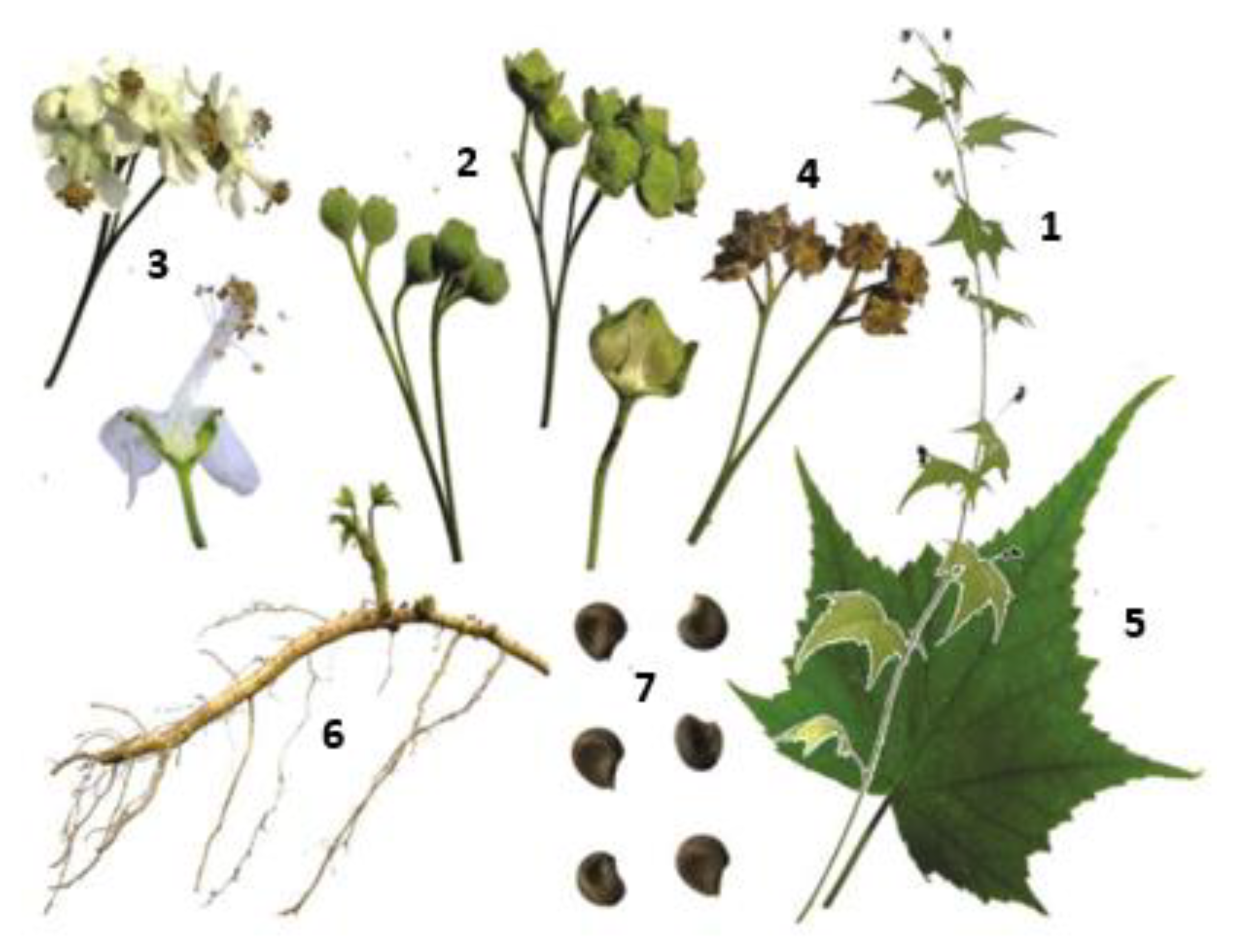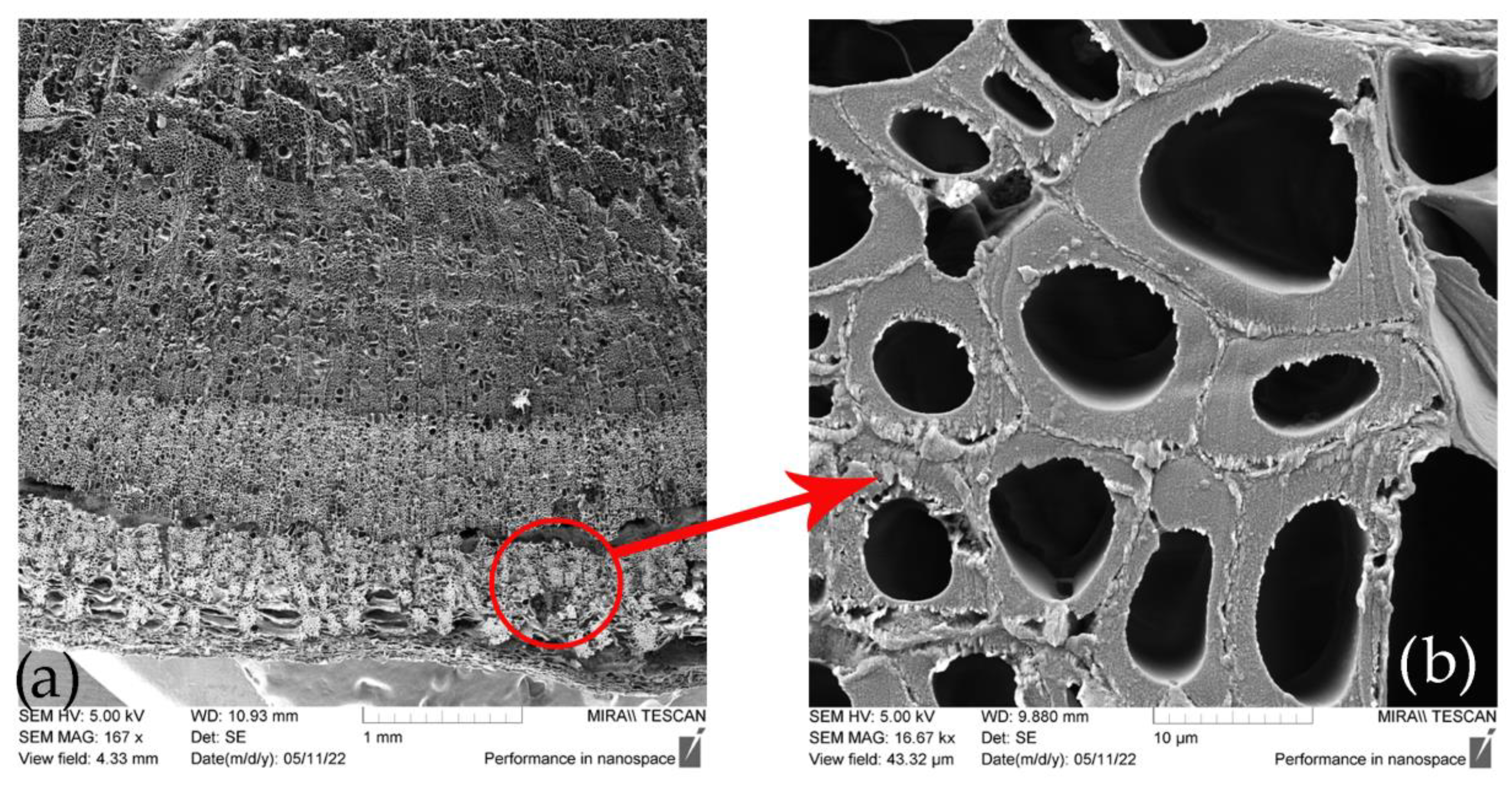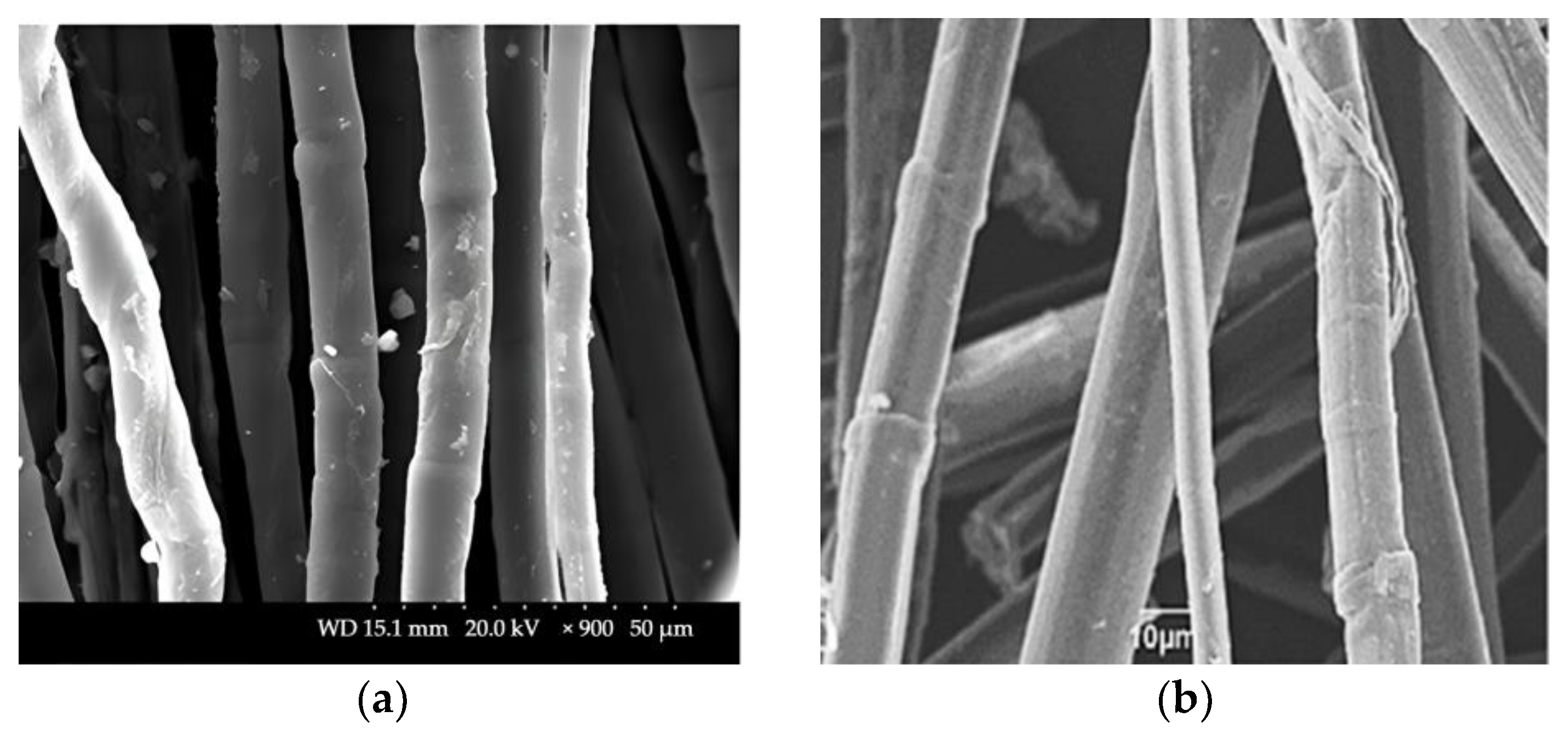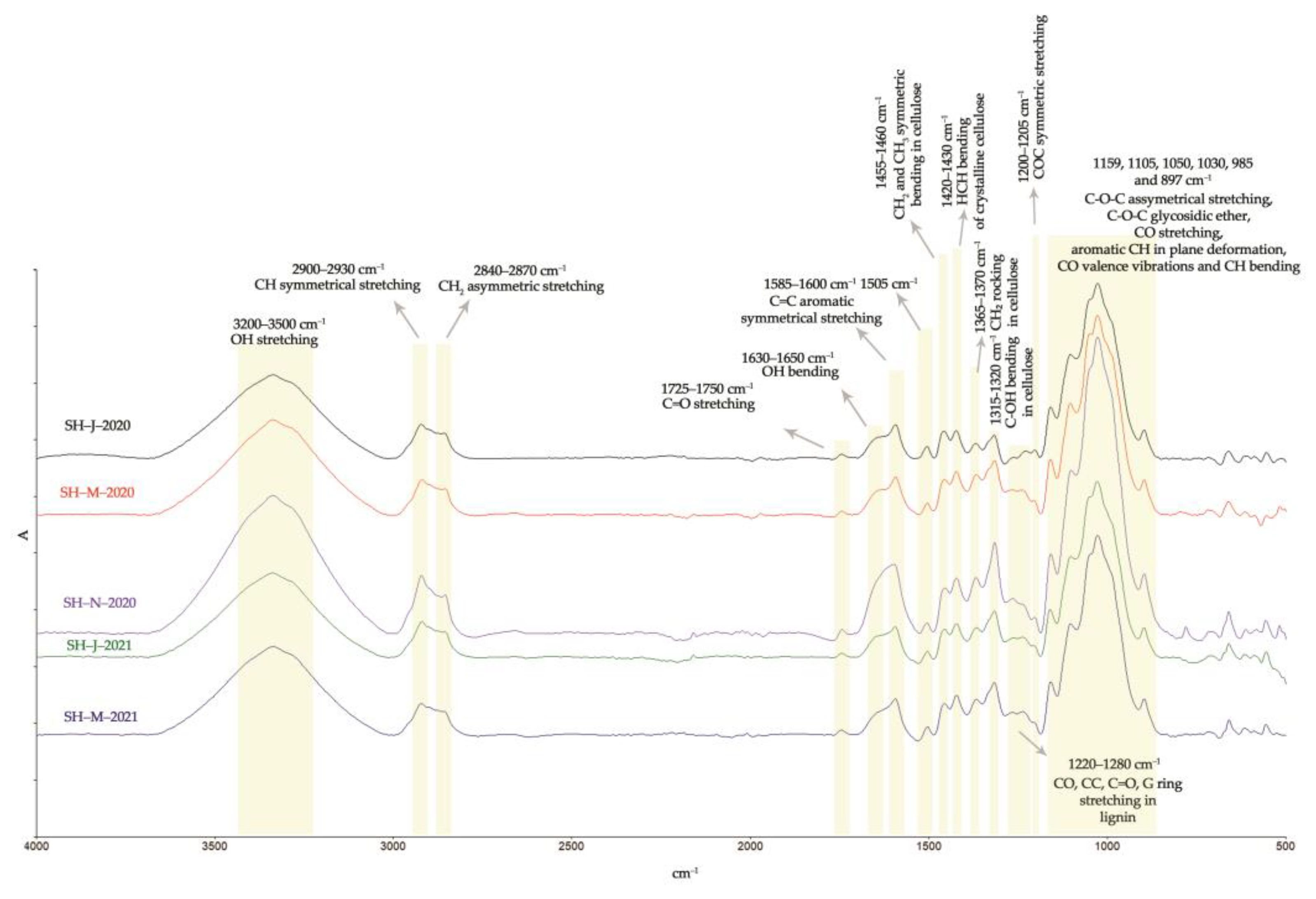3.1. Fiber Yield
The results presented in
Table 2 show that the SH variety exhibits a variable fiber yield depending on the harvest time and year.
In 2020, the fiber yield for SH was 10.29% in January, 11.12% in March, and 9.82% in November. In 2021, the fiber yield increased slightly to 10.85% in January and 11.27% in March.
The properties of natural fibers, including the fiber content in the stem, can vary depending on biological diversity, the growth conditions, irrigation, the harvesting methods, and plant age [
48,
49,
50,
51]. The properties and purity of SH fibers in the stem can depend on plant maturity, the year and time of harvest, and the part of the stem from which the fiber was isolated. The mechanical properties of fibers vary depending on their location within the stem. As for example, bottom fibers possess the poorest mechanical properties, while middle fibers exhibit the best [
52,
53]. The assumption that a more mature stem has thicker branches leads to the conclusion that the stems harvested in March 2020 and 2021 have a higher fiber content due to the plant’s maturity.
These findings suggest that climatic conditions and harvest timing have a limited impact on the fiber yield of SH. Despite the observed variations, the overall yield remained relatively consistent, suggesting that SH has stable productivity across the different seasons and years. This stability makes SH a promising candidate for industrial applications, particularly in the production of technical textiles.
Statistical analysis revealed a significant difference in the mean fiber yield values for the SH plants from the different harvests (Fcritical < Fstatistical = 3.141 and p-value = 0.037107 < 0.05). Duncan’s post hoc test confirmed insignificant differences in the fiber yield values between most harvest groups (p > 0.05), except between SH-N-2020 and SH-M-2020 (p = 0.021449) and between SH-N-2020 and SH-M-2021 (p = 0.012476). This indicates that the fiber yield of the SH plant varies insignificantly depending on the harvest, with some exceptions.
Figure 3 presents the amount of precipitation spanning over four years (2017–2021) based on data published by the Croatian Meteorological and Hydrological Service from the Zagreb Maksimir region [
54].
As shown in
Figure 3, despite the lower precipitation levels in 2021, the SH plant, which is capable of tolerating extreme continental climate conditions, including harsh winter and dry summer conditions with a minimum annual precipitation of 400–500 mm, retained its fiber yield in the stem [
15]. This statement is confirmed by
Figure 4, where the relationship between fiber yield and precipitation can be observed. It can be seen that there is no significant impact of the precipitation on the fiber yield. Regression analysis shows a negligible relationship of these two parameters, which is indicated by an R-squared value of 0.0398, implying that 96% of the variation in SH fiber yield depends on factors (fertilizers, etc.) other than precipitation [
55,
56].
The fiber yield of flax fiber (the most common representative of bast fibers) is within the range 20–25% [
57], while the yield of SH fiber from the current research is half the size. Nevertheless, the biomass dry stem yields of flax and SH are 5–10 t/ha and 10–20 t/ha, respectively, which indicate similar fiber yields from the stems [
9,
58].
Furthermore, the high percentage of solid residue remaining after SH fiber isolation (60–75%) presents an opportunity for sustainable resource utilization, such as biofuel production, supporting the circular economy model [
59]. Lignocellulosic biomass such as SH solid residues after fiber isolation should be used for the production of solid biofuels; i.e., wood chips, pellets, and briquettes; liquid biofuels, i.e., ethanol and diesel; and gaseous biofuels, i.e., biogas. The calorific value of SH fuel can be expressed as a lower heating value (LHV), which presents the energy available for upcoming usage. Bilandžija, N. et al. [
19] investigated the dependence of SH biomass LHV values over the harvest period and found out that the average LHV value of 17.85 MJ/kg indicates this crop as a valuable energy raw material for the direct combustion process. Biogas and (bio)methane production present significant economic potential in the transition from fossil fuels to renewable energy, while also contributing to the achievement of the sustainable development goals. According to the Final Report of the KK.01.1.1.04.0091 Biocomposites project [
60], the cumulative biogas and (bio)methane yields (NL/kg VS) from SH residue after fiber isolation increased by 52.57% and 22.23%, respectively, compared to the cumulative biogas and (bio)methane yields from SH biomass before the fiber isolation process over a 24-day period. By maximizing fiber use and minimizing waste, the SH variety demonstrates significant potential for contributing to zero-waste manufacturing practices.
3.2. Tensile Properties
Natural fibers exhibit anisotropic properties due to their anisotropic structure [
61]. The mechanical properties of bast fibers are mainly influenced by their biochemical composition, microfibril angle, cell geometry, secondary cell wall, cross-sectional area, and lumen size [
62,
63,
64]. A higher cellulose content increases a material’s breaking tenacity and Young’s modulus, while a higher hemicellulose content reduces a fiber’s strength due to its amorphous nature. Fiber strength is inversely proportional to elongation, with stronger fibers showing lower elongation [
65,
66].
According to this research (refer to
Table 3), the SH fibers isolated from stem harvested in November 2020 exhibited the highest fiber-breaking tenacity compared to those of the other fibers from the different harvests, with a fiber tenacity of 106.37 cN/tex. Consequently, the higher fiber tenacity of the above-mentioned fiber led to an increase in its Young’s modulus to 208.62 cN/dtex and a decrease in elongation to 4.61% compared to those of the other tested fibers; therefore, this fiber shows higher flexibility (
Figure 5). A lower modulus means softer (more ductile) fiber, which can be observed in the SH fibers harvested in January and March of 2020. The same fibers show higher strain (percentage elongation) that indicates these fibers will promote more ductile failure, which is preferable over brittle failure [
67].
Statistical analysis revealed a significant difference in the tensile strength values for the fibers from the different harvests (Fcritical < Fstatistical = 25.61 and p-value = 0.00000 < 0.05). Duncan’s post hoc test confirmed significant differences in the tensile strength values between most harvest groups (p < 0.05), except between SH-J-2020 and SH-M-2020 (p = 0.7899), SH-N-2020 and SH-J-2021 (p = 0.9086), SH-N-2020 and SH-M-2021 (p = 0.2614), and between SH-M-2021 and SH-J-2021 (p= 0.2789). This indicates that the tensile strength of fibers varies significantly depending on the harvest, with some exceptions. In this case, the winter harvest of 2020 significantly differs from the winter harvest of 2021.
Generally, the variations in the analysis results arise from the differences in the fiber chemical content, the fibers isolation methods, the plant-growing conditions, harvesting, the testing techniques, and the analyst’s expertise [
68]. Consequently, as shown in
Table 3, this result indicates high variability, which is expected for any natural fiber characterization. However, calculating the 95% confidence interval suggests that the standard error is sufficiently small, especially in sample SH-J-2020, which was tested by 1000 individual measurements, demonstrating a reasonably precise estimate.
The mechanical properties of representative bast fibers are presented and compared with the average mechanical properties of SH fiber in
Table 4. The tensile strength of SH fiber (1000–1800 MPa) is comparable to those of Flax and Spanish Broom, which can be attributed to its higher cellulose content [
40]. According to some studies [
69], strength improves with a higher cellulose content. The Young’s modulus and elongation values are similar to those of Spanish Broom. Fineness depends on the secondary cell wall structure, mainly composed of cellulose and lignin. A higher lignin content increases the fineness values; therefore, the SH fibers isolated from the plants harvested in November 2020 are finer for 28.77% than the fibers from the January 2020 harvest, suggesting a possible lower lignin content in the secondary cell wall of such fibers. Agronomic measures, such as planting density, fertilization levels, climate conditions, and hormone application, also affect fineness [
70].
We can conclude that the SH fibers isolated from the stems from any harvest are sufficiently tough and strong and compatible with other bast fibers, making them suitable for use in a wide range of industrial applications where a combination of lightness, strength, and toughness is required.
3.3. Moisture Regain and Moisture Content
The amount of moisture in a textile material is determined by the humidity of air and the type of fiber (structure, morphology, geometry, and finishing), while its sorption properties provide the fiber with functional properties and enable the conduction of physicochemical processes (dyeing and finishing) [
61]. The hygroscopic properties of natural fibers are influenced by their chemical composition, such as the –OH groups in cellulose and the –OH and acetyl groups in hemicellulose [
72,
73]. Lignin has little effect on hygroscopic behavior, while according to research [
74], pectin is water-soluble, causing fiber bundles to absorb more moisture than single fibers.
Table 5 presents the moisture content of the isolated SH fibers, showing consistent percentages across all the harvests. Notably, the lowest moisture content of 7.91% was observed in the fibers harvested in March 2021.
Statistical analysis revealed a significant difference in the mean moisture content values for the fibers from the different harvests (Fcritical < Fstatistical = 38.1 and p-value = 0.000005 < 0.05). Duncan’s post hoc test confirmed significant differences in moisture content between most harvest groups (p < 0.05), except between SH-J-2020 and SH-M-2020 (p = 0.0665) and between SH-N-2020 and SH-J-2021 (p = 0.9191). This indicates that the moisture content of fibers varies significantly depending on the harvest, with some exceptions.
According to AL-Oqla et al. and Zuhudi et al. [
75,
76], a moisture content below 10% is considered favorable, as it reduces the energy requirements for drying and facilitates easier storage maintenance. According to Kovačević [
65], fibers treated with AMW have a higher moisture content due to the successful removal of pectin, lignin, and waxes. By removing lignin, which hinders moisture penetration into the cellulose cell wall, moisture absorption is increased. Consequently, the treatment of the SH AMW fibers altered their chemical composition, crystallinity, and structure, resulting in better fiber absorbency.
Table 5 presents the standard moisture regain of the isolated SH fibers, showing consistent percentages across all the harvests, with the lowest value of 10.11% recorded in March 2021. These results align with the typical moisture regain properties of natural fibers. The moisture regain of SH fibers is comparable to those of barley and sisal fibers given in
Table 6, which are classified as straw/bast and leaf fibers. This similarity suggests that SH fibers may have desirable properties for use as reinforcement in composite materials. Although moisture absorption can increase the breaking tenacity of stem (bast) fibers, it may not be beneficial for biocomposite applications. Due to the natural tendency of plant fibers to swell when absorbing moisture, micro-cracks or voids can form at the fiber–matrix interface, leading to poor mechanical properties and the reduced dimensional stability of the composite [
77].
Natural bast fibers have recently been applied to natural geotextiles, where they can offer several benefits for agricultural use, such as preserving soil moisture, regulating temperature fluctuations, enhancing seed germination, improving filtration, reducing raindrop impact, and boosting soil fertility. They are also effective in post-wildfire soil protection, especially in areas like California, where fiber rolls are used to control erosion and sediment deposition on slopes [
81].
3.4. Density of Fibers
One of the most appealing properties of bast fibers is their low density. Fiber density significantly influences the application of textile fibers. In composite materials, particularly in the automotive industry, decreasing the weight of car parts is essential, as it helps to reduce fuel consumption and costs [
78].
As showed in
Table 7, the density of the tested SH fibers ranged from 1.52 g/cm
3 (SH-N-2020) to 1.58 g/cm
3 (SH-J-2020), which is within the typical range for natural fibers (1.2–1.6 g/cm
3) [
82]. Statistical analysis revealed a significant difference in the mean density values for the SH fibers from the different harvests (Fcritical < Fstatistical = 33.8 and
p-value = 0.00 < 0.05). Duncan’s post hoc test confirmed significant differences in the density values between most harvest groups (
p < 0.05), except between SH-J-2020 and SH-M-2021 (
p = 0.6526) and between SH-M-2020 and SH-J-2021 (
p = 0.4072). This indicates that the density of fibers varies significantly depending on the harvest, with some exceptions.
The obtained density values are influenced not only by the cellulose content, which has a density of about 1.5 g/cm
3, but also by other components like lignin and hemicellulose. Pectin is believed to have a similar density to cellulose (1.5–1.6 g/cm
3), so its presence does not significantly affect the overall density. The morphology of bast fibers, such as the size of the central lumen, also impacts density. For example, kapok fibers have a lower density (1.16 g/cm
3) than jute fibers (1.45–1.5 g/cm
3) due to a larger lumen. The other factors influencing density include residual moisture, the fiber extraction methods, geometry, porosity, and post-processing treatments [
83].
Most of the data on the density of natural plant fibers in the literature are presented after the immersion method has been used for the experimental determination of density. Le Gall et al. [
83] noted that density determination using a gas pycnometer shows 12% higher density values; therefore, the density values of the SH fibers from this study would fall into the lower range of stem fiber density.
3.5. Morphology of Fibers
Bast fibers are one of the main types of sclerenchyma cell whose main function is to provide mechanical stiffness and strength to plant (plant support tissue). Bast fibers are long, spindle-shaped, usually dead cells that have a thickened secondary cell wall consisting of lignin and high cellulose contents (60–80%). Fibers are often organized in groups or bundles and are called technical fibers [
84].
The sclerenchyma tissue close to the outer part of the stem is presented in
Figure 6a. A 16.000-times-enlarged view of a sclerenchyma fiber cell cross-section is presented in
Figure 6b. Variability in lumen size, which is quite large if compared to that of flax, hemp, jute, and Spanish broom fibers [
85], suggests the possible lower density of these fibers. Its usage for technical textiles purposes is therefore promising since it will cause new manufactured materials to be more lightweight [
34]. Longitudinal views of SH technical and elementary fibers are presented in
Figure 7. The surface morphology of the fiber closely resembles that of other bast fibers, such as hemp and flax, as shown in
Figure 8.
Each elementary fiber consists of a network of ultrafine cellulose fibrils embedded in a hemicellulose–lignin matrix [
86,
87,
88]. Pronounced wrinkles and grooves were also observed in the longitudinal view of the SH fiber, which are attributed to the use of alkali during the fiber isolation process [
89]. Kink bands on the fiber surface are associated with lower tensile strength in the fibers since they represent weak points where crack propagation starts during fiber tensile tests. The possible way of reducing kink bands, and consequently increasing fiber strength is the modification of the fiber isolation method [
90], although the environmental conditions and abiotic stress during growth are also factors that influence the shape and morphology of the kink band region [
91].
3.6. FTIR Analysis
The chemical surface properties as well as the structural properties of the SH fibers obtained from the different harvest times were investigated by FTIR analysis and presented in
Figure 9 and
Table 8.
The ATR-FTIR spectra of the investigated fibers isolated from the different harvests are presented in
Figure 9. The wide band visible in the range of 3200–3500 cm
−1 was attributed to the -OH group, while the bands within the ranges of 2900–2930 cm
−1 and 2840–2870 cm
−1 were attributed to the -CH and -CH
2 groups of cellulose, hemicellulose, pectin, fats, and waxes [
47]. The SH fibers isolated from the plants harvested in January 2020 and January 2021 exhibited the highest intensity of band at 1745 cm
−1. This peak was associated with the free -COOH group of polygalacturonic acid, which is the main constituent of pectin, and therefore the lower intensity of this peak observed within the SH fibers isolated from the autumn and spring harvests (November 2020 and March 2020) indicates a lower quantity of pectin, and thus the better quality of fiber.
The absorption band within the range of 1630–1650 cm
−1 corresponds to the water absorbed and derived from hydrogen bonding in the amorphous region of cellulose macromolecules [
92]. The fibers from November 2020 showed a lower intensity of this peak, which means less hemicellulose content, thus improving the internal organization of cellulose chains in the more crystalline regions, and consequently allowing for increased fiber strength [
65]. The SH fibers from all the harvests showed characteristic bands for lignin at 1585–1600 cm
−1 and 1505 cm
−1. The lower intensity of those peaks is noticeable in the case of the SH fibers isolated from the stems harvested in November 2020, indicating a lower lignin content [
93,
94]. The same observations were noticed for the lignin bands within the range of 1220–1280 cm
−1. The absorption band at around 1420–1430 cm
−1 corresponds to the cellulose crystalline structure, while the band at 897 cm
−1 is associated with the amorphous structure of cellulose [
65,
79,
95]. The bands at 1367 cm
−1, 1317 cm
−1, and 1203 cm
−1 are associated with the stretching and bending of the -CH
2, -OH, and C-O-C bonds in cellulose and hemicellulose [
79,
95]. In comparison to the FTIR spectra found in the literature, the fibers isolated from SH stem correspond well with the other cellulose fibers (especially bast fibers), showing the same peaks at 1159 cm
−1, 1105 cm
−1, 1050 cm
−1, 1030 cm
−1, and 985 cm
−1. These peaks are assigned to C-O-C glycosidic ether, the -CO stretching vibrations of acetyl xylan, and the -CO stretching vibrations of polysaccharide components, mainly cellulose [
79,
80].
The rigidity of cellulose fibers increases and their flexibility decreases with an increase in the ratio of crystalline in the amorphous regions. While an increase in crystallinity causes greater strength, a decrease in crystallinity causes increased elongation, higher water intake since the amorphous regions can absorb more water [
96], and more sites available for chemical reactions. A parameter called the crystallinity index (CI) has been used to present the relative amount of crystalline or amorphous regions in cellulose. The CI has been determined by XRD, solid-state NMR, IR spectroscopy, Raman spectroscopy, etc. FTIR spectroscopy turned out to be the simplest method and in good correlation with the more detailed XRD method [
97]. The crystalline characteristics of the SH fiber structure were investigated in each FTIR spectrum by comparing the peak of the functional group in the crystalline region with a peak of the other functional group in the amorphous region.
Table 8 presents the values of different crystallinity ratios (TCI, LOI, and HBI) for the SH fibers. Usually, elevated TCI and LOI values indicate the highest degree of crystallinity and a more ordered cellulose structure, while lower TCI and LOI values designate the amorphous structure of cellulose [
45,
98].
SH-J-2020 and SH-M-2021 showed the lowest TCI indexes of 0.83% and 0.95%, respectively, pointing to the higher content of amorphous domains in its cellulose chains. SH-M-2020 and SH-N-2020 have higher degree of crystallinity (TCI) and a more ordered structure (LOI) since this method is correlated to more laterally ordered macromolecular chains [
99,
100]. Although the hydrogen bond intensity (HBI) of cellulose is closely related to the degree of intermolecular crystallinity, it could relate to the lignin content as well. Both the hydrogen bonds of cellulosic and non-cellulosic components could lead to higher values of the HBI. Therefore, it is assumed that a higher value of HBI in SH-J-2020 fibers is related to lignin, which may form intramolecular hydrogen bonds between the phenolic groups [
90].

















